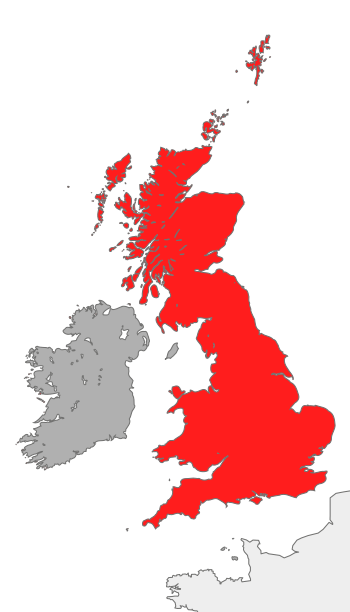Kingdom of Great Britain
United Kingdom of Great Britain | |||||||||||
|---|---|---|---|---|---|---|---|---|---|---|---|
| 1707–1800 | |||||||||||
Anthem: God Save the King/Queen | |||||||||||
 Map of the kingdom's lands | |||||||||||
| Capital | London | ||||||||||
| Common languages | English (throughout) Welsh (Wales) Scots (Scotland) Scottish Gaelic (Scotland) | ||||||||||
| Demonym(s) | Briton,British | ||||||||||
| Government | Constitutional monarchy | ||||||||||
| Monarch | |||||||||||
• 1707–1714 | Anne | ||||||||||
• 1714–1727 | George I | ||||||||||
• 1727–1760 | George II | ||||||||||
• 1760–1801 | George III | ||||||||||
| Prime Minister | |||||||||||
• 1721–1742 | Robert Walpole | ||||||||||
• 1783–1801 | William Pitt the Younger | ||||||||||
| Legislature | Parliament | ||||||||||
| House of Lords | |||||||||||
| House of Commons | |||||||||||
| History | |||||||||||
| 1 May 1707 | |||||||||||
| 31 December 1800 | |||||||||||
| Area | |||||||||||
| 1801 | 230,977 km2 (89,181 sq mi) | ||||||||||
| Population | |||||||||||
• 1801 | 10942646 | ||||||||||
| Currency | Pound sterling | ||||||||||
| ISO 3166 code | GB | ||||||||||
| |||||||||||
1 The royal motto used in Scotland was Latin: Nemo me impune lacessit, lit. 'no-one provokes me with impunity' | |||||||||||
The United Kingdom of Great Britain[1] was a state in the British Isles.[2] The kingdom came into existence because of the Acts of Union 1707.[3] These acts of parliament joined (unified) the Kingdom of Scotland and the Kingdom of England.[4] The kingdom's lands were Great Britain (an island in the Atlantic Ocean near Continental Europe) and some other islands in the British Isles. Throughout its existence, the kingdom was in a personal union (sharing the same monarchy) with the Kingdom of Ireland. Outside the British Isles, Great Britain governed other lands and started colonies: the British Empire.
When the kingdom began, the Parliament of Scotland and the Parliament of England joined into one legislature, the Parliament of Great Britain. The parliament met in the old Palace of Westminster in London. London was the capital city and the British government was there. The two earlier kingdoms of Scotland and England had been in a personal union (sharing the same monarchy) since the reign of James VI and I. King James was a King of Scots who became King of England and King of Ireland in 1603 because he inherited the kingdoms of Elizabeth I.
In 1801, by the Act of Union 1800, the Kingdom of Great Britain and the Kingdom of Ireland joined into the United Kingdom of Great Britain and Ireland after the putting down of the Irish Rebellion of 1798.
Monarchs[edit]
Anne became Queen of England, Queen of Scotland, and Queen of Ireland in 1702. She became Queen of Great Britain when the new kingdom started in 1707. (Ireland was a separate kingdom, so Anne was Queen of Ireland and the later kings of Great Britain were each themselves King of Ireland.) From the start of 1801, during the reign of George III, the two kingdoms of Ireland and Great Britain became the United Kingdom of Great Britain and Ireland.
House of Stuart[edit]
- Anne (1707–1714)
House of Hanover[edit]
- George I (1714–1727)
- George II (1727–1760)
- George III (1760–1801), continued as King of the United Kingdom of Great Britain and Ireland until 1820.
References[edit]
- ↑ Union with England Act 1707 (Scotland), Article 2 ff.
- ↑ Murdoch, Alexander (2007). "England, Scotland, and the Acts of Union (1707)". Oxford Dictionary of National Biography (online ed.). Oxford University Press. doi:10.1093/ref:odnb/96282. (Subscription or UK public library membership required.)
- ↑ "Act of Union 1707". UK Parliament. Retrieved 2021-05-01.
The Acts of Union, passed by the English and Scottish Parliaments in 1707, led to the creation of the United Kingdom of Great Britain on 1 May of that year. The UK Parliament met for the first time in October 1707.
- ↑ "Act of Union 1707: Key dates". UK Parliament. Retrieved 2021-05-01.
| Preceded by: Kingdom of England c 927–30 April 1707 Kingdom of Scotland c 843–30 April 1707 |
United Kingdom of Great Britain 1 May 1707 – 31 December 1800 |
Succeeded by: United Kingdom of Great Britain and Ireland 1 January 1801–5 December 1922 |



